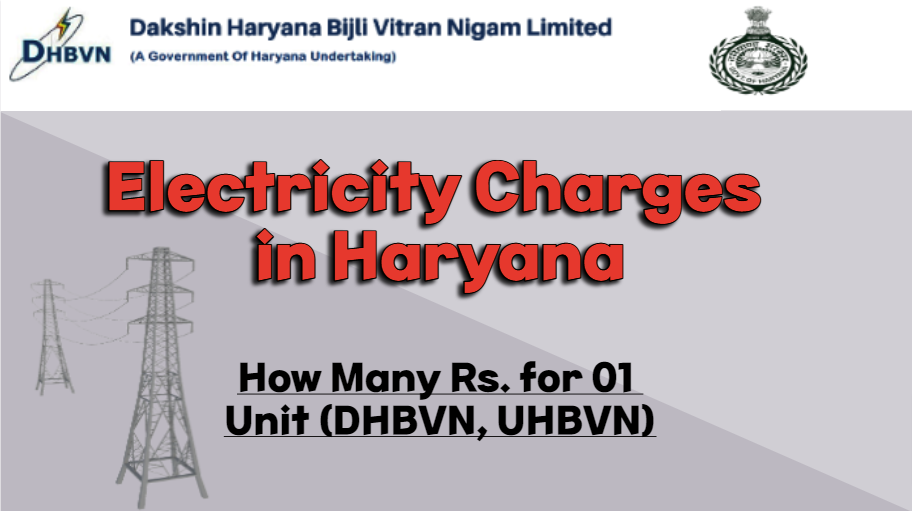Electricity is a lifeline in modern society, powering homes and businesses alike. In the state of Haryana, understanding your electricity charges is crucial for budgeting and managing energy consumption. This article will explain how electricity bills are calculated in Haryana and offer tips for reducing your energy costs.

Article Contents
Electricity Distribution in Haryana
Haryana has two major electricity distribution companies (DISCOMs):
- Dakshin Haryana Bijli Vitran Nigam (DHBVN): Serving the southern districts of the state.
- Uttar Haryana Bijli Vitran Nigam (UHBVN): Covering the northern districts of the state.
Both DHBVN and UHBVN use a similar structure for electricity bills, which we’ll break down below.
How Your Electricity Bill is Calculated in Haryana
Your electricity bill in Haryana is calculated based on the following factors:
- Units Consumed (kWh): ‘Kilowatt-hour’ is the basic unit of electrical energy. Your electricity meter tracks your household or business consumption in kilowatt-hours (kWh).
- Slab-Based Tariff: Haryana uses a telescopic slab-based system. The charges per unit change depending on how much electricity you use per month. Higher consumption slabs have higher unit charges to encourage energy conservation.
- Fixed Charges: This is a monthly fee charged regardless of your usage. It contributes to covering the DISCOM’s operational and maintenance costs.
- Electricity Duty: A tax levied by the Haryana government on electricity consumption.
- Fuel Surcharge Adjustment (FSA): This is a variable charge that reflects the fluctuations in the cost of fuel used to generate electricity.
Electricity Charges for Domestic Consumers in Haryana
Here’s a table outlining the latest domestic electricity charges in Haryana (please check the official websites of DHBVN and UHBVN for real-time updates):
| Consumption Slab (Units per month) | Tariff (Rupees per unit) |
|---|---|
| 0-50 | Rs. 2.00 |
| 51-150 | Rs. 2.50 |
| 151-250 | Rs. 5.25 |
| 251-500 | Rs. 6.30 |
| 501-800 | Rs. 7.10 |
| Above 800 | Rs. 7.10 |
Note: Fixed charges, electricity duty, and FSA are additional and may vary slightly as per DISCOM policies.
Understanding Your Electricity Bill
Your monthly electricity bill will typically showcase the following:
- Billing Period: The time covered by the bill.
- Meter Readings (Previous & Current): Used to calculate your consumption.
- Units Consumed (kWh): The total measured in kilowatt-hours.
- Slab-Wise Calculation: Demonstrates how your bill is calculated based on your consumption slab.
- Fixed Charges, Electricity Duty, FSA, Other Charges: Itemized charges.
- Net Payable Amount: The final amount due.
Tips on Saving Electricity and Lowering Your Bill
- Energy-Efficient Appliances: Choose appliances with a good star rating.
- Opt for LEDs: Replace bulbs with energy-saving LED options.
- Utilize Natural Light: Maximize daylight to reduce artificial lighting.
- Unplug Unused Electronics: Avoid phantom power consumption.
- Regular AC Maintenance: Clean filters for optimal performance and lower energy use.
Final Remarks
By understanding the rate structure and taking energy-saving steps, you can manage your electricity expenses effectively in Haryana. Regularly check the official websites of DHBVN and UHBVN for the most current tariffs and updates.
FAQs
- Where can I find the latest electricity tariffs for Haryana?
- Visit the official websites of DHBVN (https://www.dhbvn.org.in/) and UHBVN (https://www.uhbvn.org.in/).
- How do I calculate my electricity bill?
- Multiply your unit consumption by the respective slab rates and add fixed charges, FSA, and electricity duty.
- Are there any subsidies for electricity bills in Haryana?
- The Haryana government may offer subsidies under specific schemes. Check the DISCOM websites for details.
